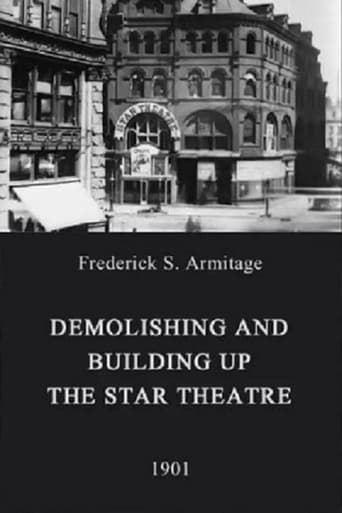

Time-lapse photography is used to show the manual dismantling and demolition of New York's Star Theatre over a period of about thirty days.I have to assume that the "building up" is simple dismantling shown in reverse, because if these builders were able to construct a theater in thirty days, that would be amazing in itself. But either way, is this the first time-lapse film? It had to be one of the first, and it really captures something grand.We are also left to wonder about the building in the foreground that keeps taking its awning down and putting it back up up. While that was probably normal at he time, it seems strange today when awnings comes attached to the building and never go away.
... View MoreSkyscrapers of New York from the East River (1903) *** (out of 4) A camera is placed on a boat and we get another view of the buildings in NYC. I'm not sure what time this film was shot but the streets are pretty empty.Panorama from Tower of Brooklyn Bridge (1903) *** (out of 4) Biograph film from director Billy Blitzer who would eventually become famous for his work with D.W. Griffith. It's also worth noting that this was shot in 65mm.Demolishing and Building Up the Star Theatre (1901) *** 1/2 (out of 4)Early gimmick film from Biograph uses exposures caught every four minutes to see the Star Theatre being built. At the end of the film the footage is shown backwards to bring the thing down.Coney Island at Night (1905) ** 1/2 (out of 4) Edison film directed by Edwin S. Porter shows just what the title says. This film really isn't too interesting but it's worth noting that this was one of the first film that could show glowing lights thanks to a special camera built by Porter.
... View MoreFor 1901, this footage is impressive both in its creativity and in its quality. It would be easy to believe that it had been made much later than it actually was. The time-lapse technique works remarkably well, and it creates an interesting and very watchable movie.The idea is a simple one, but ambitious for its time. As a massive old theater building was being torn down, a film crew from American Mutoscope & Biograph set up a stationary camera timed to take photographs at regular intervals over the entire course of the process, creating a fast-paced movie of the building's demolition. The illusion works perfectly, and it is also very interesting to watch. Almost as interesting as the building itself are some of the other details in the surrounding neighborhood. An awning in the foreground continually appears and disappears, along with many other such details.The earliest film-makers often showed quite an imagination and some determined resourcefulness in their efforts to get the most out of their equipment. Although footage like this is now more commonplace and is easier to obtain, this pioneering effort well deserves to be remembered and watched.
... View MoreA fascinating example of timelapse photography, and quitepossible the first. Shot from one angle, the movie begins with areal time shot of a building across the street, the Star Theater.Vehicles of all kinds crowd the street below, and the sidewalk isbustling with people.Then time flashes forward. As though watching somebodydressed in layers of clothes start to strip, we watch as Stardisappears, pealed away layer by layer by an ant-like demolitioncrew. The final shot, still from the same angle, is again in realtime, showing people and vehicles passing through the street,past what is now a vacant lot.We're so used to seeing examples of this same sort of scenenow, it's strangely unnerving to see it happen 102 years ago. Thepicture quality of the print I saw was extremely crisp, and finedetails (even the faces of passersby on the street) were visible.The only thing I didn't like so much was seeing a beautiful buildingget torn down. Still, at least it was all captured on film for us to seenow. A fascinating document.
... View More